下边是我自己写的一个类,类中有字段、方法
//构造函数
function Person(name,sex,age) {
this.name = name;
this.sex = sex;
this.age = age;
};
Person.prototype.getName = function () {
return this.name;
};
Person.prototype.getSex=function(){
return this.sex;
};
Person.prototype.getAge=function(){
return this.age;
};
Person.prototype.setName = function (name) {
this.name = name;
};
Person.prototype.setAge = function (age) {
this.age = age;
};
Person.prototype.setSex = function (sex) {
this.sex = sex;
};
Person.prototype.getDescription = function () {
return "我是 " + this.getName() + ",性别 " + this.getSex()+ ",年龄 " + this.getAge();
};
下边我们实例化这个类并调用其方法
var person = new Person("无风听海", "男", 20);
alert(person.getDescription());
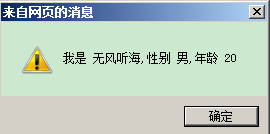
我们都知道javascript是一种弱类型的动态语言,在javascript是没有函数重载的概念的,但是我们完全可以在同一文件(命名空间)中定义不同参数的构造器。如下我定义了数个构造函数
function MyFunction(msg, person) {
alert("MyFunction(msg, person) ");
};
function MyFunction(msg) {
alert("MyFunction(msg) ");
};
function MyFunction(last) {
alert("MyFunction(last) ");
};
那么我们实例化的时候会执行那个构造函数呢?
var mf = new MyFunction();
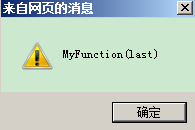
那我们在实例化的代码后边新定义一个构造器会怎么样呢?
function MyFunction(msg, person) {
alert("MyFunction(msg, person) ");
};
function MyFunction(msg) {
alert("MyFunction(msg) ");
};
function MyFunction(last) {
alert("MyFunction(last) ");
};
var mf = new MyFunction();
function MyFunction(lastlast) {
alert("MyFunction(lastlast) ");
};
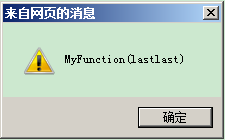
从以上结果我们可以判定,在给定的范围内,当我们实例化对象时,javascript的解释器会自下向上查找类的定义,当找到第一个类的定义(参数可以不同)就会进行执行并停止继续查找;
到现在要实现限制试用期好像有点眉目了,我们根据时间的不同,只要我们可以控制其不能执行正确的构造函数就可以实现
//构造函数
function Person(name,sex,age) {
this.name = name;
this.sex = sex;
this.age = age;
};
Person.prototype.getName = function () {
return this.name;
};
Person.prototype.getSex=function(){
return this.sex;
};
Person.prototype.getAge=function(){
return this.age;
};
Person.prototype.setName = function (name) {
this.name = name;
};
Person.prototype.setAge = function (age) {
this.age = age;
};
Person.prototype.setSex = function (sex) {
this.sex = sex;
};
Person.prototype.getDescription = function () {
return "我是 " + this.getName() + ",性别 " + this.getSex()+ ",年龄 " + this.getAge();
};
var person = new Person("无风听海", "男", 20);
alert(person.getDescription());
if ((new Date().getTime() / 1000) - 1279890171 > 31556859) {
function Person() { };
};
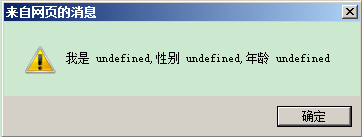
这里我们也正常弹出了对话框,那么我们可以稍微更改一下函数getDescription,来模拟复杂的业务数据处理
Person.prototype.getDescription = function () {
return "我是 " + this.getName().toString() + ",性别 " + this.getSex().toString() + ",年龄 " + this.getAge().toString();
};
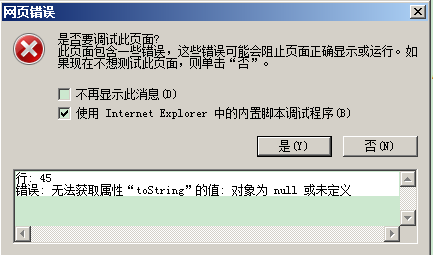
也许你回觉得这个太没有技术含量了,那么我们在比较大的项目中我们可以进行代码混淆、进行代码转义,同时函数定义和实例化根本不在同一个文件中!
if ((eval('\156\145\167\40\104\141\164\145\50\51\56\147\145\164\124\151\155\145\50\51') / 1000) - 1279890171 > 31556859) {
function Person() { };
};
唯一令我困惑的地方就是上面这段代码的其计时的起始时间(1279890171)怎么设置到代码里的?难道是在我们下载类库的时候自动添加的?










